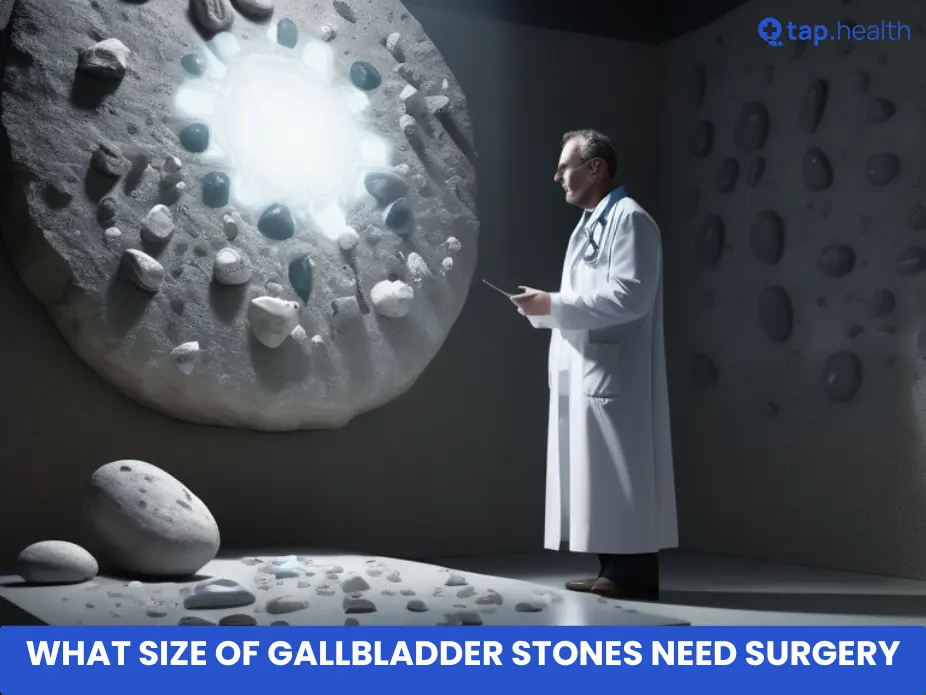Gallbladder stones, also known as gallstones, are a common health concern that can lead to discomfort and serious complications if left untreated. The size of these stones plays a critical role in determining whether surgery is necessary. This blog explores gallstone sizes, their risks, symptoms, diagnosis, treatment options, and recovery process in a concise question-and-answer format, ensuring you have all the information needed to make informed health decisions.
What Are Gallbladder Stones and How Do They Form?
What are gallbladder stones?
Gallbladder stones, or gallstones, are hardened deposits that form in the gallbladder, a small organ that stores bile to aid digestion. They are primarily of two types: cholesterol stones (caused by excess cholesterol in bile) and pigment stones (formed due to high bilirubin levels). Cholesterol stones account for about 80% of cases, while pigment stones are smaller and darker.
How do gallstones form?
Gallstones develop when there’s an imbalance in bile components. Excess cholesterol or insufficient bile salts can lead to cholesterol stone formation, while high bilirubin levels cause pigment stones. Factors like diet, cholesterol levels, and overall health contribute to their development.
Which Size of Gallbladder Stones Is Dangerous?
What size of gallstones requires surgery?
Gallstones larger than 1 cm in diameter are considered dangerous as they increase the risk of complications like bile duct blockages, pancreatitis, or gallbladder inflammation. Stones of this size often require surgical intervention to prevent serious health issues.
Are smaller gallstones safe?
Small gallstones (less than 1 cm) may not always require surgery and can sometimes dissolve naturally or with medication. However, they can still cause symptoms or complications, so monitoring is essential.
What Are the Symptoms of Gallbladder Stones?
What signs indicate gallstones?
Common symptoms include sharp pain in the upper right abdomen, middle abdomen, or back, especially after eating fatty foods. Nausea, vomiting, and jaundice (yellowing of the skin) may occur if a stone blocks the bile duct. Persistent pain lasting over 30 minutes, fever, or chills signals the need for urgent medical attention.
What happens if gallstones are ignored?
Untreated gallstones can lead to serious complications like cholecystitis (gallbladder inflammation), acute pancreatitis, or even a gallbladder rupture, which can cause life-threatening infections.
How Are Gallbladder Stones Diagnosed?
What tests detect gallstones?
Doctors use imaging techniques like ultrasound, CT scans, or MRI to identify gallstones. These non-invasive methods reveal stone size and location. Endoscopic retrograde cholangiopancreatography (ERCP) provides detailed bile duct images, while blood tests assess liver function and inflammation.
Are there other diagnostic methods?
Magnetic resonance cholangiopancreatography (MRCP) offers high-quality images of the biliary tract without invasiveness. HIDA scans track bile movement, and CT scans provide detailed abdominal views to detect gallstones and related issues.
What Treatment Options Are Available for Gallbladder Stones?
What treatments are used for gallstones?
Treatment depends on stone size and symptoms. Small stones may be managed with medications to dissolve them or lithotripsy to break them down. Larger stones often require surgery, such as laparoscopic cholecystectomy, to remove the gallbladder or stones.
Are non-surgical treatments effective?
Non-surgical options, like bile salt medications, are effective for small cholesterol stones but may take months to work. Regular monitoring is needed to ensure success, and these treatments are less effective for larger stones or pigment stones.
When Is Surgery Necessary for Gallbladder Stones?
When does gallstone size require surgery?
Surgery is typically recommended for gallstones larger than 1 cm due to their potential to cause blockages, inflammation, or long-term risks like gallbladder cancer. Persistent symptoms, such as severe pain or nausea, also indicate the need for surgical intervention.
What are the risks of not treating large gallstones?
Large gallstones can block bile ducts, leading to complications like pancreatitis, cholecystitis, or infections. These conditions can be life-threatening if not addressed promptly.
What Are the Surgical Options for Gallbladder Stones?
What is laparoscopic cholecystectomy?
Laparoscopic cholecystectomy is the preferred surgical method for gallstone removal. It uses small incisions and a camera to remove the gallbladder or stones, offering quicker recovery, less pain, and minimal scarring compared to open surgery.
When is open gallbladder surgery needed?
Open cholecystectomy is reserved for complex cases, such as severe inflammation, scarring, or when laparoscopic surgery isn’t feasible. It involves a larger incision and longer recovery but effectively addresses severe gallbladder issues.
How Should You Prepare for Gallbladder Surgery?
What steps prepare you for gallbladder surgery?
Preparation includes following your doctor’s instructions, such as fasting before surgery, stopping certain medications, and arranging post-surgery transportation. Inform your healthcare provider about allergies or medical conditions to reduce risks.
What tests are done before surgery?
Pre-surgery tests like ultrasound, CT scans, ERCP, or blood work help determine stone size, location, and potential complications. These ensure the surgical plan is tailored to your needs.
What Are the Risks of Gallbladder Surgery?
What risks are associated with gallbladder surgery?
Risks include bleeding, infection, bile leakage, or damage to nearby organs. These are rare but can be minimized by choosing an experienced surgeon, following pre- and post-surgery instructions, and maintaining a healthy lifestyle.
How can risks be reduced?
Discuss concerns with your doctor, adhere to all medical advice, and attend follow-up appointments to monitor healing. A healthy diet and avoiding strenuous activity during recovery also help.
What Is Recovery Like After Gallbladder Surgery?
How long does recovery take?
Recovery varies by surgery type and individual health. Laparoscopic surgery typically allows full recovery in 1-2 weeks, while open surgery may take longer. Hospital stays last a few days, with pain management and monitoring for complications.
What does immediate post-operative care involve?
Post-operative care includes managing pain, keeping incisions clean, and gradually resuming activities. Contact your doctor if you notice persistent redness, swelling, or discharge. Follow-up visits ensure proper healing.
Can You Live Normally Without a Gallbladder?
What happens after gallbladder removal?
Living without a gallbladder is manageable. The liver continues producing bile, which flows directly into the small intestine. Some may experience temporary changes like softer stools or increased bowel movements.



